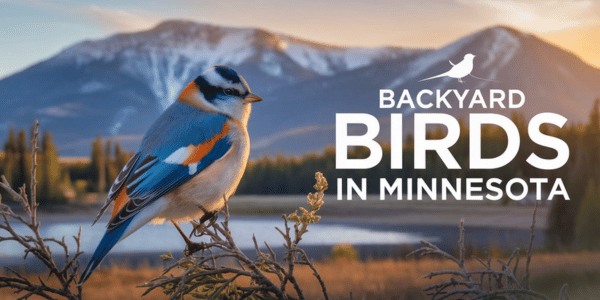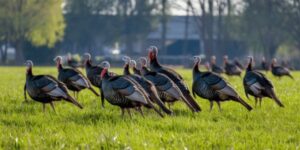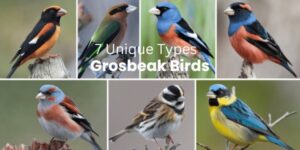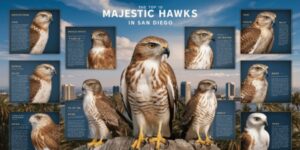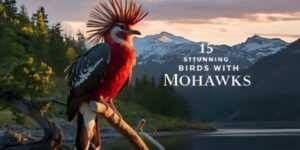With its diverse landscapes and rich natural habitats, Minnesota is home to various backyard birds. Whether you are an avid birdwatcher or a casual observer, the state offers an opportunity to witness some of the most captivating avian species in your backyard. These birds are not only a delight to watch but also play a crucial role in the ecosystem, contributing to the balance of nature. Below, we explore Minnesota’s most beautiful backyard birds, highlighting their unique features and behaviours.
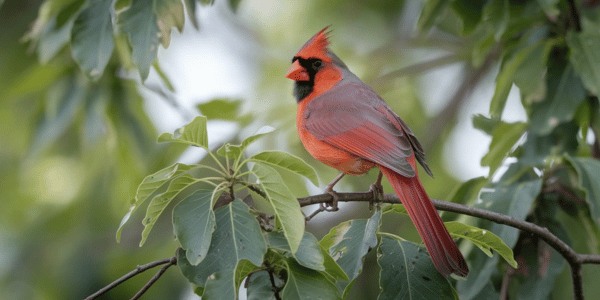
Northern Cardinal (Cardinalis cardinalis)
Identification and Characteristics:
Amongst North America’s most known and loved birds is the Northern Cardinal, whose males have vibrant red feathers that make them easily noticeable. Males possess striking bright red bodies with black masks on their faces, while females have subdued colours with pale brown bodies and reddish wings, tails and crests that are warm in colour. Both sexes display a distinctive crest on their heads coupled with a solid conical beak for breaking seeds apart. Adult northern cardinals measure about 8-9 inches long with wing spans of about 10-12 inches.
Habitat and Behavior:
Northern Cardinals inhabit different environments, such as woods, gardens, and shrublands. They are not migratory, making them year-round residents of much of the eastern United States. Foraging grounds for cardinals are usually situated in low bushes or grassy parts, where they feed passively on seeds, fruits, or even insects. Their straightforward whistling song can be heard any time of the year. The males, especially, are highly vocal as they sing to establish territories or ward off other intruders from their territory.
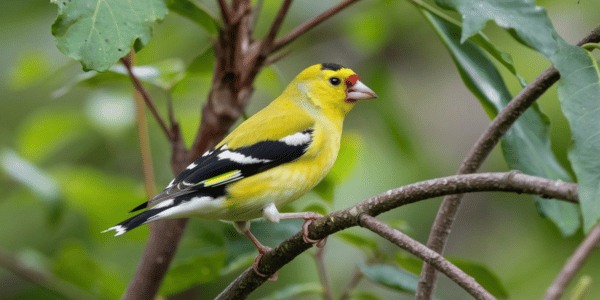
American Goldfinch (Spinus tristis)
Identification and Characteristics:
An agile-flight small bird often coloured yellow brightly is referred to as the American Goldfinch, which is one such bird you may find within your premises. Males appear striking during the breeding season, with bright yellow bodies, black wings, white markings, and a black head crown. Females are duller coloured with olive-brownish bodies and fewer mark-ups. Off the breeding grounds, both sexes moult their bright feathers for drabber shades of yellowish brown. They measure about 5 inches long, with wing spans ranging between 7-9 inches.
Habitat and Behavior:
American Goldfinches are like open places such as fields, meadows, and gardens near seed sources, representing their primary food. These birds are highly social, typically occurring in flocks, especially when not breeding. Contrary to most songbirds whose nestlings are hatched early in the spring, American Goldfinches time their nesting to follow the peak availability of seeds in mid to late summer. They fly distinctively by bobbing up and down as they go along. In addition, goldfinches are also famous for their singing, often heard while on “the wing”.
You May Also Like: 15 Stunning Birds With Mohawks
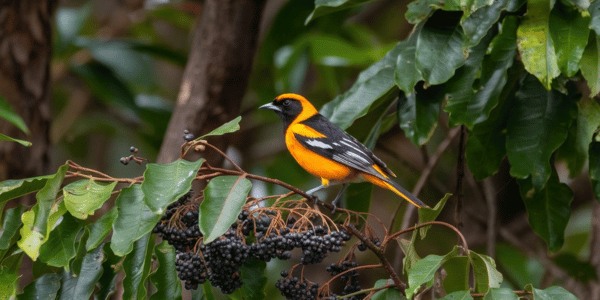
Baltimore Oriole (Icterus galbula)
Identification and Characteristics:
Such a stunningly beautiful bird is called the Baltimore Oriole. Males display a bright orange body, a black head, and black wings with white bars on them. On the other hand, females have different colours, including yellow-orange bodies with grey-coloured wings. The two sexes possess bills, but it should be remembered that Baltimore’s oriole average length is seven to eight inches, and its wing span is nine to twelve inches.
Habitat and Behavior:
The Baltimore Orioles can be commonly found in open forest areas, especially along rivers, the edges of forests and orchards. These birds are known for their complex hanging nests that are woven out of plant fibres and hung from the ends of tree branches. Primarily, they eat insects, fruits, and nectar, making them frequent garden visitors with blooming flowers or fruit trees. Its song is a series of rich-fluted whistles often heard during the breeding period.
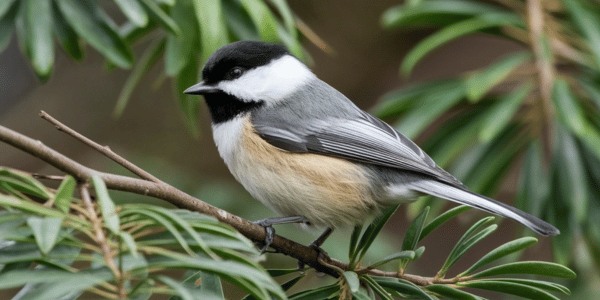
Black-capped Chickadee (Poecile atricapillus)
Identification and Characteristics:
With their black cap and bib, white cheeks, and greyish body, the black-capped chickadee is easy to identify. They have an approximate length of about 4.5-5.5 inches and a wing span between 6-8 inches across. In spite of being small-sized creatures, they are famous for being bold and curious when it comes to humans seeking food.
Habitat and Behavior:
Black-capped Chickadees prefer deciduous woods or mixed forests and parks along suburban regions. They stay all year long within their natural boundaries, often darting through trees and searching for insects, seeds, or berries. With respect to winter season periods, especially during mixed-species flock composition, chickadees’ social behaviour leads to forming small groups that congregate together, thus making different types of vocalizations like the “chick-a-dee-dee-de” call that changes with intensity and pitch depending on a situation.
You May Also Like: 11 Red-Headed Birds of Hawaii
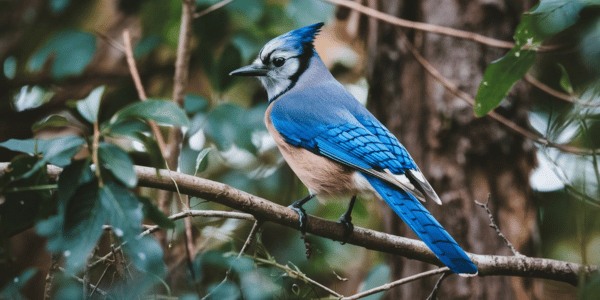
Blue Jay (Cyanocitta cristata)
Identification and Characteristics:
The Blue Jay bird has bright blue upperparts and a white face. Its underparts are also white but have a distinct black necklace running over the throat. It is further distinguished by its crest, which appears prominent. Its wings are rounded and have alternate bands of white colouration at intervals alongside those coloured black. This bird measures about 9-12 inches, with its wing span extending between 13-17 inches.
Habitat and Behavior:
Blue Jays are found in forests, woodlands, and cities throughout eastern and central North America. They are intelligent and adaptable birds with loud calls and mimicry (including the capacity to imitate hawks). They consume seeds, nuts, fruits, insects, and sometimes small vertebrates; they also cache food for future reference, mostly burying seeds/acorns, leading to forest regeneration.
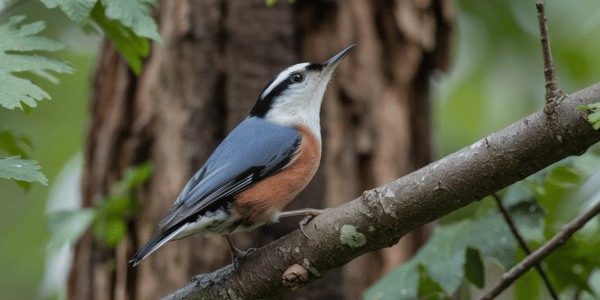
Red-breasted Nuthatch (Sitta canadensis)
Identification and Characteristics:
The Red-breasted Nuthatch is a small bird with a compact body structure and a straight-pointed beak. Its tail is short. The bird’s plumage is blue-grey above and rust-red underneath. It has a black cap on top of the head and a characteristic white line over its brow. The nuthatch measures about 4.5 inches long, and its wing span is approximately 8-9 inches.
Habitat and Behavior:
These species are usually present across America’s coniferous forests, although they can be seen migrating in mixed forests or suburban areas. They are known as agile climbers moving upside-down along tree trunks, searching for hidden insects under the bark. The nuthatches have nasal yammering type of song that may be regular or irregular in pattern depending on activity level; they also store food inside crevices during winter periods when these supplies become limited.
You May Also Like: The Ultimate Guide to Blue-and-Gold Macaws

Ruby-throated Hummingbird (Archilochus colubris)
Identification and Characteristics:
The Ruby-throated Hummingbird is a tiny, rainbow bird with males sporting a brilliant ruby-red throat patch, green upperparts, and whitish underparts. Females lack ruby-throats and are more passive in colour. Both sexes possess a long, slender bill specifically adapted to feed on nectar, thus enabling them to hover at flowers while feeding themselves. Its length measures about 3-4 inches, with a wing span ranging between 3-4 inches.
Habitat and Behavior:
Ruby-throated Hummingbirds are common in gardens, forests, and prairies throughout eastern North America. They are migratory birds that spend the winter in Central America and return to North America during spring. These hummingbirds can fly at great speeds with agility while hovering or flying in any direction. Their diet mainly consists of nectar from flowers, small insects, and spiders. Males exhibit territoriality by defending their feeding territories against other hummingbirds.
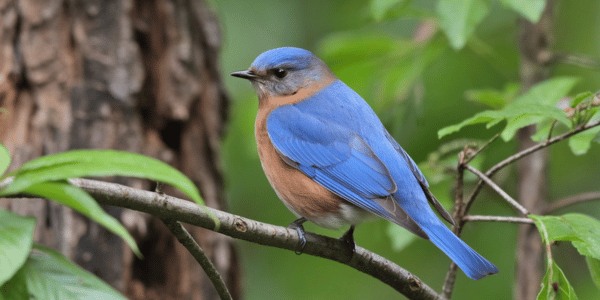
Eastern Bluebird (Sialia sialis)
Identification and Characteristics:
The Eastern Bluebird is a small thrush with bright blue upperparts and a reddish-brown breast and throat. While males have brighter colours, females have duller colours with bluish-grey wings and lighter orange breasts. They measure 6.5-8 inches long, with wing spans ranging between 9-12 inches.
Habitat and Behavior:
Eastern Bluebirds inhabit open areas like fields, meadows, and orchards, where they often sit on fences or wires scanning for insects. They prefer nesting cavities such as those provided for them by people’s nest boxes. Bluebirds are family birds most commonly seen in groupings of two to ten individuals, especially when there is enough sunlight to perform their soft warbling songs from spring to summer, mostly consisting of insects or berries.
You May Also Like: What Time Do Birds Wake Up? Amazing Secrets

House Finch (Haemorhous mexicanus)
Identification and Characteristics:
House finches are generally plump little birds having conical beak shapes as well as notched tails. Females lack the red plumage which characteristically appears on males’ faces and the upper part of the breast towards streaked backside or belly brownish body colour finishing out through down-wrapped wings. Adults average about 5-6 inches long across with 8-10 inch wing-span.
Habitat and Behavior:
Often seen in suburban and urban areas, House Finches are one of the most adaptable birds found in deserts and open woodlands. During the winter, they usually form small flocks. They enjoy feeding on seeds, fruits, and buds, thus visiting bird feeders frequently. The House Finch’s song has a cheery, warbling tone in all seasons.

American Robin (Turdus migratorius)
Identification and Characteristics:
The American Robin is a well-known bird with a greyish-brown back, reddish-orange breast, and white eye-rings that can be distinguished from afar. Its average body length is between 9 and 11 inches, while its wing span measures about 12 to 16 inches. American Robins’ arrival in numerous places in North America often signals spring.
Habitat and Behavior:
These birds can live in many habitats, such as woodland gardens, lawns or parks. They normally forage on earthworms insects like beetles caterpillars or spiders or even fruit such as cherries or berries . Their song consists of a series of rich whistling phrases that sound melodious. Moreover, they are among the earliest nesting species, often producing several broods per season. Robins exist everywhere; they are highly adaptable to various environments, making them one of the most widespread birds in North America.
Conclusion
The variety of backyard birds in Minnesota reflects the state’s diverse wildlife. To attract these beautiful creatures into your garden, you need to create an environment filled with different types of food sources, including native plants, water elements, and feeders. Bird-watching enthusiasts, whether beginners or experts, will find solace by simply seeing any one of them around because they add beauty to nature. Take pleasure in watching these fantastic fliers!

